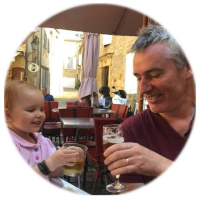

by Ian Bertie MBCS – updated – 23/11/21
The fundamental questions that it is critical to answer within the first 7 seconds.
When someone lands on your web page, they expect to find the information they are looking for immediately. Statistics suggest you have around 7 seconds to offer the information or value they are looking for before they become just another bounce statistic.
It is essential to use the fold, (the bit of the website a user sees before they have to scroll), to deliver relevant content and calls to action that will help to keep your visitors engaged right from the very beginning, increasing the chances of your visitor exploring your offerings even further.
Statistics have shown the median time spent on a first visit to a website is 7 seconds. In that time it is essential you demonstrate to your visitor the following:
1. Who the website is for?
2. What is it that you can do for me?
3. Why should I care?
4. OK What should I do now?
When someone lands on your website, the first thing they want to know is “is this website for me?” That is to say who are you aiming at? What is your niche?
If your customer profile is dog owners, then state clearly somewhere in the fold, “for Dog Lovers” or if you cater to the retired, make it clear.
Not everyone who visits your website is looking for your product or service, but some definitely are and you need to make it obvious to those people that you are a the right fit for them.
It seems obvious, but you would be surprised at how many websites do not make this distinction.
It probably seems obvious to you, but for someone landing on your website for the first time, who may not be an expert or have any understanding of your products or services; if they don’t get a clear idea of what value you can offer to them immediately then they will leave .
OK you cannot express all the details of you offerings within 7 seconds, but you must at the very least whet their appetite enough to scroll on and find out more.
The better the visitors understand your offerings, the better they are positioned to make a conversion.
Many businesses have a false belief that their visitor is there to learn something about their company. The hard truth is they really don’t care about you (us). They care about discovering what it is that you can do to solve their problem. How can you help them?
Make your message about your audience, not about you. In short, your website needs to demonstrate the benefits that you can offer your visitors, and do so quickly enough to grab their attention and encourage them to find out more.
Why is it important to get people to stay on your website?
The more time someone spends engaged in your content, the more they will see you as an expert in your field and in turn this will build trust and increase the likelihood they will make contact..
Google measures the amount of time a visitor spends on your website and uses it as part of its ranking algorithm.
If someone spends a lot of time on your website and visits multiple pages, Google (and other search engines) see this as engagement and demonstrating useful, educational and interesting information. Exactly the sort of outcome they are looking for when they rank websites.
So your visitor has discovered you can answer their need, what next?
It is astonishing to see how many websites do not have any obvious call to action features within the fold of their website or at best may only have a “contact us” button on the menu.
You have gone to all the trouble and expense of creating an awesome website and attracting quality visitors, make it easy for them to contact you.
This is where you need your call to action, or multiple calls to action. Depending upon the type of product or service you provide.
Typically we would recommend at least three options.
A clickable telephone number. As around 60% of your visitors are likely to be using a mobile device to view your website, having your phone number as a link is a no-brainer. Visitors can click on you number and their telephone will bring it up in their keypad display so all they need to do is click the dial button.
A button call to action that activates a pop up form. Again as most of your visitors will be on a mobile, a button that opens a fast form is essential. The form should be short, limiting the fields to Name, email address and maybe telephone number. The shorter the form, the more responses you will get.
A link or links to further information. Many products and services, especially the more expensive purchases, require your visitor think carefully and ask many questions. If you can provide answers to some of the more common questions through easy to read and find articles, you will bestow a feeling of confidence and expertise upon your reader making it easier for them take further action and connect with you.
Remember though, you need to have call to action options available throughout your website.
There are other options you can use that are also very effective. The call back button is a good example, if your business is set up to manage it. Your visitor puts their telephone number into a form and click send, you receive and alarmed email notification and call you prospect back immediately. (or you can use a direct call connect service who will connect you with your prospect)
Another very effective option is the chat feature. Statistics have shown that websites with a chat feature will get 44% more enquiries than those without.
Find out more about the call to action here
Firstly, congratulations and thank you for reading this far, I am guessing you are very serious about your business and are looking for an amazing website that will rank high in the search engines and convert visitors into leads or customers.
We at a38.com are able to help, contact us now but any of the means on this page and we will call you as soon as possible to find out your needs.
We offer a complete no obligation free quotation service.
Call now on 07885 225 233

Torcroft
Devon Tors Road
Yelverton
Devon
PL20 6DN
Email: ian@a38.com
PHONE: 07885 225 233
Copyright A38.com. 2021 all rights reserved

